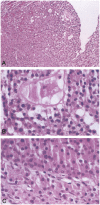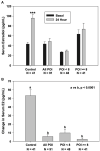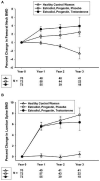Optimizing Fertility in Primary Ovarian Insufficiency: Case Report and Literature Review
- PMID: 34249096
- PMCID: PMC8261244
- DOI: 10.3389/fgene.2021.676262
Optimizing Fertility in Primary Ovarian Insufficiency: Case Report and Literature Review
Abstract
Primary ovarian insufficiency (POI) is a clinical spectrum of ovarian dysfunction. Overt POI presents with oligo/amenorrhea and hypergonadotropic hypogonadism before age 40 years. Overt POI involves chronic health problems to include increased morbidity and mortality related to estradiol deficiency and the associated osteoporosis and cardiovascular disease as well as psychological and psychiatric disorders related to the loss of reproductive hormones and infertility. Presently, with standard clinical testing, a mechanism for Overt POI can only be identified in about 10% of cases. Now discovery of new mechanisms permits an etiology to be identified in a research setting in 25-30% of overt cases. The most common genetic cause of Overt POI is premutation in FMR1. The associated infertility is life altering. Oocyte donation is effective, although many women prefer to conceive with their own ova. Surprisingly, the majority who have Overt POI still have detectable ovarian follicles (70%). The major mechanism of follicle dysfunction in Overt POI has been histologically defined by a prospective NIH study: inappropriate follicle luteinization due to the tonically elevated serum LH levels. A trial of physiologic hormone replacement therapy, clinically proven to suppress the elevated LH levels in these women, may improve follicle function and increase the chance of ovulation. Here, we report the case of a woman with Overt POI diagnosed at age 35 years. To attempt pregnancy, she elected a trial of intrauterine insemination (IUI) in conjunction with follicle monitoring and physiologic hormone replacement therapy. She conceived on the eighth cycle of treatment and delivered a healthy baby. Our report calls for a concerted effort to define the best methods by which to optimize fertility for women who have POI.
Keywords: hormone replacement therapy; intrauterine insemination; luteinized follicles; pregnancy; primary ovarian insufficiency.
Copyright © 2021 Piedade, Spencer, Persani and Nelson.
Conflict of interest statement
LN is employed by companies William Brown Consulting, LLC and My Family Cares, LLC. The remaining authors declare that the research was conducted in the absence of any commercial or financial relationships that could be construed as a potential conflict of interest.
Figures




Similar articles
-
Successful fertility preservation following ovarian tissue vitrification in patients with primary ovarian insufficiency.Hum Reprod. 2015 Mar;30(3):608-15. doi: 10.1093/humrep/deu353. Epub 2015 Jan 6. Hum Reprod. 2015. PMID: 25567618
-
Achievement of pregnancies in women with primary ovarian insufficiency using close monitoring of follicle development: case reports.Endocr J. 2013;60(6):791-7. doi: 10.1507/endocrj.ej13-0031. Epub 2013 Feb 27. Endocr J. 2013. PMID: 23445562
-
A form of secondary ovarian insufficiency (SOI) due to adrenal hypoandrogenism as new infertility diagnosis.Endocrine. 2021 Apr;72(1):260-267. doi: 10.1007/s12020-020-02512-0. Epub 2020 Oct 2. Endocrine. 2021. PMID: 33009651
-
Follicle development and its prediction in patients with primary ovarian insufficiency: Possible treatments and markers to maximize the ability to conceive with residual follicles.Reprod Med Biol. 2023 Dec 22;22(1):e12556. doi: 10.1002/rmb2.12556. eCollection 2023 Jan-Dec. Reprod Med Biol. 2023. PMID: 38144239 Free PMC article. Review.
-
Life plans and family-building options for women with primary ovarian insufficiency.Semin Reprod Med. 2011 Jul;29(4):362-72. doi: 10.1055/s-0031-1280921. Epub 2011 Oct 3. Semin Reprod Med. 2011. PMID: 21969270 Review.
Cited by
-
Spontaneous pregnancy after tracking ovulation during menstruation: A case report of a woman with premature ovarian insufficiency and repeated failure of in vitro fertilization.Front Med (Lausanne). 2022 Dec 8;9:994674. doi: 10.3389/fmed.2022.994674. eCollection 2022. Front Med (Lausanne). 2022. PMID: 36569135 Free PMC article.
-
The truth about 17-beta estradiol: menopause beyond "old wives' tales".Front Endocrinol (Lausanne). 2023 Sep 11;14:1229804. doi: 10.3389/fendo.2023.1229804. eCollection 2023. Front Endocrinol (Lausanne). 2023. PMID: 37766693 Free PMC article. No abstract available.
-
Family size for women with primary ovarian insufficiency and their relatives.Hum Reprod. 2023 Oct 3;38(10):1991-1997. doi: 10.1093/humrep/dead168. Hum Reprod. 2023. PMID: 37632248 Free PMC article.
-
Endocrine disorders and fertility and pregnancy: An update.Front Endocrinol (Lausanne). 2023 Jan 17;13:970439. doi: 10.3389/fendo.2022.970439. eCollection 2022. Front Endocrinol (Lausanne). 2023. PMID: 36733805 Free PMC article. Review.
-
Premature ovarian insufficiency.Nat Rev Dis Primers. 2024 Sep 12;10(1):63. doi: 10.1038/s41572-024-00547-5. Nat Rev Dis Primers. 2024. PMID: 39266563 Review.
References
-
- Bestetti I., Castronovo C., Sironi A., Caslini C., Sala C., Rossetti R., et al. . (2019). High-resolution array-CGH analysis on 46, XX patients affected by early onset primary ovarian insufficiency discloses new genes involved in ovarian function. Hum. Reprod. 34, 574–583. 10.1093/humrep/dey389 - DOI - PMC - PubMed

